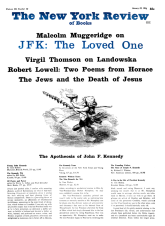In response to:
Trompe l'Oeil from the December 3, 1964 issue
To the Editors:
John Richardson is a distinguished critic and connoisseur, for whom I have the highest professional and personal esteem. However, his recent article of Life with Picasso by Françoise Gilot is, I feel, strongly colored by his friendship for Pablo and Jacqueline Picasso. Since this is an important book and deserves to be taken seriously, may I add a footnote in the interest of historical accuracy?
The article begins with the statement that everything about Picasso is interesting because everything about his life is related to his art. This is so. And yet two paragraphs later Mr. Richardson takes violent exception to the excessive intimacy of Madame Gilot’s portrait. Now the fact is that Picasso himself has chosen to live in a fish bowl. He may not have bargained for the total transparency of the facet of it with which Madame Gilot has provided us, but he has no one to blame for that but himself, and it ill becomes others to take exception to it. I think it is significant that in spite of his strictures concerning the book and its author Mr. Richardson never categorically states that this portrait of Picasso is a false one. He neglects to do so, I believe, for the excellent reason that he is in a position to know how astonishingly true to life the portrait is. Whether or not Madame Gilot is to be admired for having drawn it is neither here nor there. Certain minor inaccuracies and distortions may exist, but essentially the image is of striking fidelity and brilliance. It is important to know how perverse, cruel, ruthless, sentimental, and promiscuous Picasso could be. Indeed, how could anyone honestly study his work and imagine him to be otherwise? It is also important to know that upon occasion no one could be more charming, witty, incisive, magnetic, responsive, and generous. Perhaps Madame Gilot was moved by bitter memories to neglect these aspects of Picasso’s personality. However, what she says about him all in all is essentially the truth, and no one who knows him can deny it. The reported conversations may not be absolutely accurate, but to me, at least, they are quite convincing, and how precious and fascinating it is to have so many of his ideas and judgments. Further, the secondary portraits are by and large to my knowledge very true to life. One cannot always say agreeable things about people, particularly if one presumes to be dealing with the truth. Take, for example, one of Picasso’s “favorites,” Alice B. Toklas: the most mocking and unpleasant things I’ve ever heard said about that charming, rather pathetic person were said by Picasso.
It may be that Madame Gilot has not drawn a very prepossessing portrait of herself. But, after all, who cares? She has drawn a striking, profound, truthful portrait of Picasso. For that, I believe, she is to be thanked.
James Lord
New York City
This Issue
January 28, 1965



